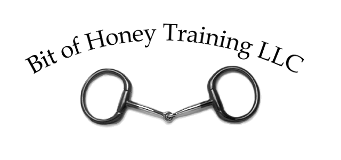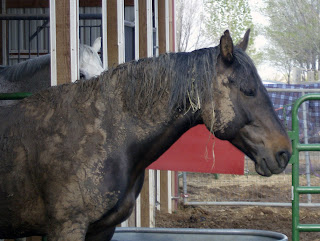 |
| Highboy has been working through Ex 4a |
Today was his third time in the round pen. These are very short and low-stress sessions because his body can't handle too much exertion in circles yet. He understands the voice commands for walk, trot, whoa, and reverse. He doesn't hold his gaits yet, so he won't continue trotting without prompting from me, but he is listening very carefully, and trying desperately hard to do the right things. Today was fun because I had my dogs out with me, and the border collies are very horse-savvy. Belle just stays out of the way of the green horses, but the more trained ones she deposits her frisbee under them, just in case they want to play. Miles waits at their head if they look nervous, and usually he has quite a calming effect on anxious horses. Highboy is in the midst of determining where he fits into the horse herd hierarchy, so he told Miles to leave him alone. I verbally released Miles and he waited by the tack room until we were ready to head to the round pen.
Once in the round pen I set up one pole, and observed Highboy walking and trotting over it both directions. He got progressively more careful as he realized what was expected of him. This is a good exercise, as long as it's done slowly and in a controlled and relaxed way. The horse is able to think through the exercise and realize that if he picks his feet up and moves them a prescribed distance with each step, he won't hit the pole. I like them to reason their way through it, rather than rushing and getting wound up with stress hormones pumping. I don't learn well when I'm rushed or stressed, and neither do horses. Additionally, in a PT setting it is counter productive to have the horse rushing, since we are trying to create more strength and mobility through his haunches and lower back and this is best done through slowly developing the muscling through strengthening exercises. All this was done today with Miles running laps in the round pen with us, attempting to play with the lunge whip but having the latent effect of making Highboy quite dog-proof.
 |
| Highboy worked through a simplified version of Ex 3a in the round pen, using only 1 pole |
Once we did a few minutes of work with the ground pole I was curious how he would respond to the surcingle, both as preparation for saddling and preparation for therapy with therabands. I discovered I need a much shorter cinch, but I did put the pad, surcingle, and breastplate on too. It did make a slight difference in how he moved, striding out a bit more with his limbs both to the L and R. Tomorrow we'll try with equipment that fits a little better, but today's response indicates that he may do well with therabands used correctly.
It's very exciting to me to see even these subtle changes in Highboy. He is much more agreeable now, much less mouthy. He eats his mash and finished his hay the last two nights in a row, and really has started to feel at home. I can tell because he has begun WWF horse wrestling with Cole, Major, and Billy over the fence. When they are turned out together there is some racing around, but mostly lip wrestling and then grazing. All good young horse socializing behaviors, and it makes for a more relaxed new kid.






























.jpg)



















